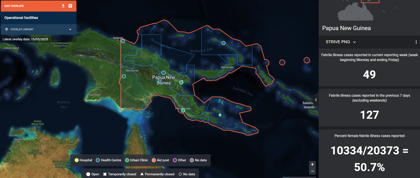Infectious diseases are an increasing global health threat, especially in low- and middle-income countries. There is an urgent need for continuous monitoring, rapid diagnosis and accurate tracking of infectious disease cases.
The STRIVE project strengthens health systems across Melanesia by supporting local partners to monitor and respond to vector-borne diseases.
Vector-borne diseases are a type of infectious disease transmitted by living organisms (vectors). The vectors carry pathogens such as parasites, viruses or bacteria that infect humans. Mosquitoes are a vector that carry the parasite that causes malaria and many other vector-borne diseases.
STRIVE stands for Strengthening Integrated Surveillance and Response for Vector Borne Diseases in Melanesia. The project aims to:
- improve surveillance (finding and tracking) of vector-borne diseases and emerging or priority pathogens
- remove barriers that are making it difficult for healthcare workers to monitor and respond to vector-borne diseases.
STRIVE operates through an explicit partnership-based approach involving joint decision-making, co-design of activities, shared resources and mutual accountability.
Pictured left to right:
- The Molecular Hub team in Port Moresby. You can learn more about their collaborative research and resource sharing in this video on YouTube.
- Serology scientists James and Shannah setting up their first assays at the Papua New Guinea Molecular Hub.
- Vector control officer Stephen training in setting up monitoring traps for mosquito surveillance.
- STRIVE’s sentinel site in Sausi in Madang Province, one of eight clinics within the STRIVE sentinel site network.
Project aims
- Aim 1: Embedded sustainable capacity and systems for integrated sentinel surveillance.
- Aim 2: Consolidated genomic and serological laboratory surveillance capabilities.
- Aim 3: Embedded vector surveillance and response capacity within sub-national health teams.
- Aim 4: Strengthened health systems supports, enabling effective surveillance and use of data for decision-making.
- Aim 5: Strengthened partnerships and empowered local researchers, partners, and organisations.
- Aim 6: One health approach integrated into surveillance and molecular diagnostic frameworks.
- Aim 7: Assess climate change’s impact on vector-borne diseases, health systems, and livelihoods.
- Aim 8: Increase accessibility and utilization of gender equity, disability, and social inclusion data to inform national activities and policies.
Key achievements
In Phase 1 of the project, Burnet and Papua New Guinea Institute of Medical Research (PNGIMR) partnered with Papua New Guinea- and Australia-based organisations to identify barriers to malaria data collection, establish ongoing monitoring processes, rapidly identify new outbreaks, and support government and health workers in data-based decision making. Key achievements are as follows:
- We worked together with local teams to increase their ability to trap, monitor, and analyse mosquito populations, including their resistance to insecticides.
- We adopted a tool called Tupaia to visualise VBD data from 8 sentinel sites (clinics) across PNG. This tool allows for real-time surveillance and response to outbreaks.
- We improved our laboratories’ ability to test for diseases such as malaria, dengue, chikungunya, zika, Ross River virus, Barmah Forest virus and COVID-19. We also monitor if these diseases are becoming resistant to treatments.
- We assessed how health workers use surveillance data and worked out what makes it difficult for them to access and use this information.
- We started using mSupply to better manage and track our medical supplies.
- During the COVID-19 pandemic, we adapted our operations so that we could measure antibodies for COVID-19 and help guide the response in Papua New Guinea.
In phase 2 of the project, we aim to use what we have learned in phase 1 to expand on existing activities in Papua New Guinea and to also share knowledge with partners in Solomon Islands and Vanuatu.
The 2024 STRIVE annual report shares stories and news about the progress we’ve made over the last year.

More information
For more information, please contact leanne.robinson@burnet.edu.au.
Collaborators
Implementation lead: PNG Institute of Medical Research (PNGIMR)
PNG Central Public Health Laboratory (CPHL)
PNG National Department of Health (NDoH)
The University of PNG School of Medicine and Health Sciences (SMHS)
The National Agriculture Quarantine and Inspection Authority (NAQIA)
Vanuatu Ministry of Health (VMoH)
Solomon Islands Ministry of Health and Medical Services (SI MHMS)
Walter and Eliza Hall Institute (WEHI)
Australian Institute of Tropical Health and Medicine (AITHM) at James Cook University
CSIRO Australian Centre for Disease Preparedness (ACDP)
Australian Defence Force Malaria and Infectious Disease Institute (ADFMIDI)
Funding partners
2018-2023: Supported by the Australian Government through the Department of Foreign Affairs and Trade’s Indo-Pacific Centre for Health Security
2024-2028: Supported by the Australian Government through the Partnerships for a Health Region Initiative

Burnet project team
Meet the project team. Together, we are translating research into better health, for all.



















